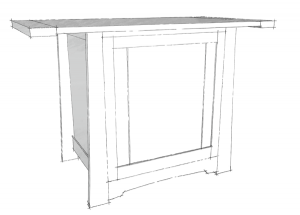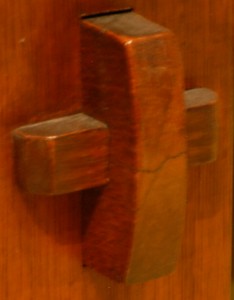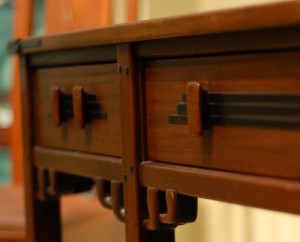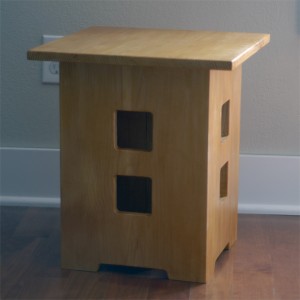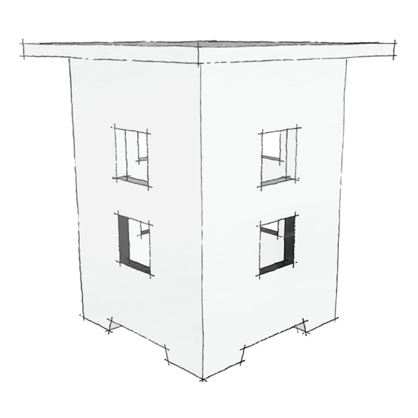Unlike other makers represented in the Metropolitan Museum’s collection, the work of George Nakashima is not on display in a gallery. Instead, it furnishes the entry room to the museum’s Japanese galleries. Consequently you can sit at a large conference table in a sculpted chair and run your hands over the glassy smoothness of the slab top or inspect the inlaid butterfly keys. Continue reading
Category Archives: Furniture
An Arts & Crafts TV Stand–Construction
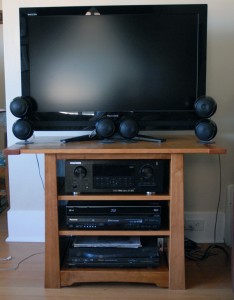
The reverse tapered legs, overhanging top, and stepped arch on the bottom rail place this TV stand in the West Coast Arts and Crafts style.
The stand is essentially a case bookended by two face frames, with the frames’ stiles extending below the bottom rail to form legs. I began by cutting the side top and bottom rails to size and using a slot cutter to rout a 1/2″ deep x 1/4″ wide groove in one edge of each rail. I then cut side panels from some 1/2″-inch plywood and routed a rabbet along the short edges of the panel. I like to pre-finish my projects when I can, and I took that approach here. After sanding through 250 grit, I wiped a coat of boiled linseed oil onto the side components and followed with a couple of coats of blonde shellac, then wet sand to 400 grit. With the finish in place, I glued the tongues on the plywood panels to rabbets on the rails. To finish the box, I cut the bottom and top panels from 1/2″ plywood, finished them, then attached them to the side using loose tenons.
An Arts & Crafts TV stand — design
If design is about solving problems, then the problem I was attempting to solve with this design for a minimal tv stand was that of grasping hands. The knobs and buttons of my home theater components were proving irresistible to my toddler son, and I wanted to replace my existing stand–a wide, Shaker-ish piece with open shelves–with something smaller and enclosed. Continue reading
Stickley at the Met
Gustav Stickley is perhaps the most famous name in the American Arts & Crafts movement. Certainly he was its greatest proponent, extolling the virtues and benefits of the movement in the pages of The Craftsman. The clean lines, visual mass, and joinery as ornament Stickley championed are evident in the pieces featured in the Metropolitan Museum’s collection. On display in gallery 743 are a small sideboard, tall clock, and leather-covered library table, and the museum’s viewable storage features a Harvey Ellis-designed music case. Continue reading
The holdings of the Metropolitan Museum’s Gallery 743 read like a greatest hits list of American Arts & Crafts makers, featuring pieces by Gustav Stickley, Dick Van Erp, William Lightfoot Pierce, Arthur Frank Mathews, Charles Rohlfs, and the Byrdcliffe Colony.
Included in the collection are a library table, dining chair, and lantern Charles and Henry Greene designed as part of a commission for the retired lumberman Robert Blacker. As with much of the furniture designed by the Greenes, these pieces were built in the shop of Peter Hall. Emil Lange, formerly of Tiffany Studios, made the lantern’s glass panels. Continue reading
An Arts and Crafts Picture Frame
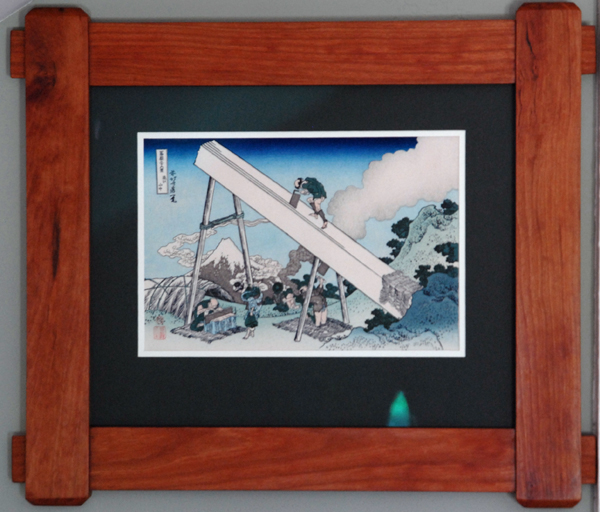 I was delighted to find this Hokusai print while in Kyoto and wanted to build a frame with an Arts & Crafts influence. I didn’t have to look far for a suitable design–several American Arts & Crafts makers produced mirrors in this style with the stiles capturing rails in through tenons. Continue reading
I was delighted to find this Hokusai print while in Kyoto and wanted to build a frame with an Arts & Crafts influence. I didn’t have to look far for a suitable design–several American Arts & Crafts makers produced mirrors in this style with the stiles capturing rails in through tenons. Continue reading
Limbert No. 234 Side Table–Construction
I’ve admired the No. 234’s design for some time, but at 18 inches, it seems a little short for a side table. Before committing to white oak or cherry for my final project, I rehearsed the build in pine. Since the wide board I picked up had some nice quarter-sawn figure along both edges, I took some time cutting around knots and glued up the top and base. While my panels dried, I prepared the template, laying out the pattern on a piece of plywood and building a quick frame sized for the square cutouts. Using a template for the cutouts on the template requires substantially less time than drilling out the corners of each cutout, sawing close the line and sanding and filing to final shape. Continue reading
Limbert No. 234 Side Table–Design
The No. 234 features the square cutouts found in many of Limbert’s designs (see also the No. 367 bookcase). Here they echo, in negative form, the square top. The 16-inch top is centered on a 12-inch columnar base. At 18 inches high, it is shorter than the usual height of side tables, but two together make an interesting alternative to a coffee table. A tapered notch forms two feet on on each side.
A Craftsman-style Hall Table–Construction
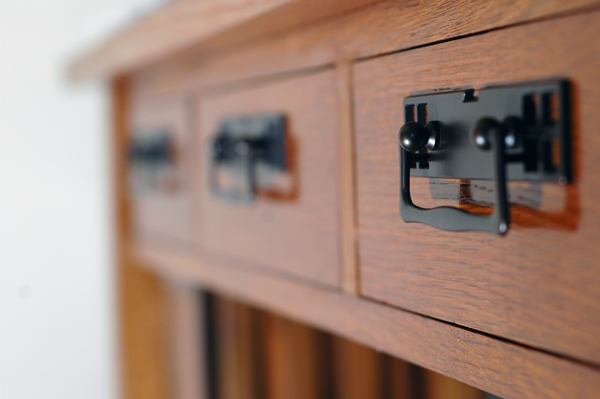 Construction began with stock preparation. Usually I try to avoid dimensioning stock, but my usual lumber sources don’t carry surfaced quarter-sawn white oak. I thicknessed my stock and set the base material aside to concentrate on the top.
Construction began with stock preparation. Usually I try to avoid dimensioning stock, but my usual lumber sources don’t carry surfaced quarter-sawn white oak. I thicknessed my stock and set the base material aside to concentrate on the top.
The top is a full inch thick, giving it a pleasant heft and accentuating its horizontal line. I took some time arranging boards until satisfied with the design then glued it up and moved on to the base. Continue reading
A Craftsman-style Hall Table–Design
One of the things on our “must have” list when home shopping was an entry way; we didn’t want to walk directly into a living room. Our hall isn’t large, but it provides a transitional space between outdoors and in. And it is big enough for a table and chair, a place to put on shoes or take off a coat. While we had space for a table, we didn’t actually have the table. We wanted something in the Craftsman style scaled to the space. A quick check with the tape measure showed something about 40″ w x 36″ h x 14″ d fit the bill. I flipped through the library looking at every example of hall tables and related designs I could find and put together this design in SketchUp.
An inch-thick top gives the table some heft, and the slats and through tenons ally the design with the work of Gustav Stickley. A telescoping webframe supports three drawers while the bottom shelf creates some additional storage and adds another horizontal line to what might otherwise be a very vertical design.


